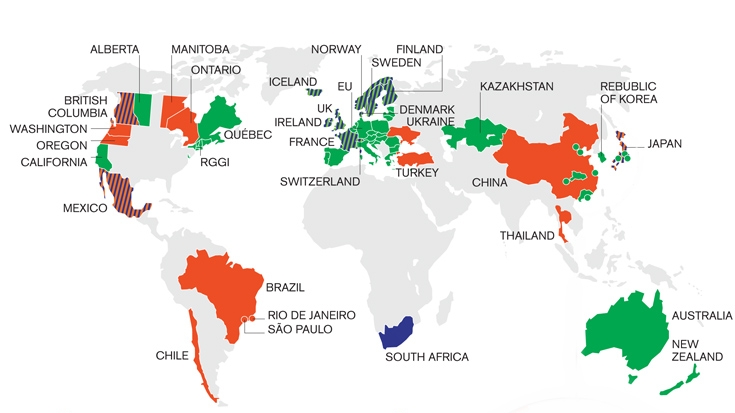The International Context
This is a decisive year for climate action. In September, UN Secretary-General Ban Ki-moon will host a climate summit in New York to build the political momentum and ambition needed to reach a global climate change agreement in 2015. The World Bank Group and others are encouraging countries, sub-national jurisdictions, and companies to join a growing coalition of first movers supporting carbon pricing.
The lengthy discussions inherent in complex climate negotiations have been reflected in the international market. Countries with emission reduction targets under the second commitment period of the Kyoto Protocol represent about 12 percent of global greenhouse gas emitters.
A robust global solution and greater use of carbon pricing could strengthen private sector confidence to invest in low-carbon solutions and technology. Private sector action is essential to any solution: A substantial technological, economic, institutional, and behavioral shift to low-carbon development is necessary to avoid global temperatures rising more than 2 degrees Celsius above pre-industrial levels, and time is of the essence.
“It is clear that carbon pricing policies are here to stay – the widespread use of these policies in all corners of the globe is striking,” said Alyssa Gilbert, head of market-based mechanisms at Ecofys and lead author of the State & Trends reportfrom Ecofys and the World Bank Group. “The diversity of approaches will help policy-makers learn what works and what doesn't and will contribute to our ability to improve the effectiveness of this tool in combating climate change."
Carbon Pricing Approaches
Given the size and urgency of the climate challenge, a full range of carbon pricing policies and instruments will be required to bring down emissions and address climate change.
The report examines the different approaches to carbon pricing and where each is in use. Carbon taxes guarantee a carbon price in the economic system, while emissions trading systems provide certainty about the environmental impact through a cap on emissions. Both have a positive impact on economic decision-making by internalizing the cost of climate change through a price on carbon and bringing down greenhouse gas emissions. They also help raise revenues that may provide additional incentives to invest in low-carbon growth.
The reach of carbon pricing is steadily increasing: the world’s two largest emitters are now home to carbon pricing instruments.
Carbon pricing systems are now in operation in sub-national jurisdictions of the United States and China. For example, California’s cap-and trade program was launched in December 2012 and entered into its first compliance period on Jan. 1, 2013. In 2015, is will increase to 85 percent coverage of the state’s greenhouse gas emissions. China’s six pilot emissions trading systems, in Shenzhen, Shanghai, Beijing, Guangdong, Hubei, and Tianjin, are up and running, and a national ETS is anticipated in China sometime during the 13th Five Year Plan (2016-2020).
In addition, the discussions between these two countries on climate action raise promising perspectives at the global level.
"While overall progress at the national level in China and the United States may take some time, it is remarkable that the world’s two largest emitters are now home to carbon pricing instruments," said Alexandre Kossoy, senior financial specialist at the World Bank and team leader of the report. "In fact, with the six Chinese pilots operational, China now houses the second largest carbon market in the world, covering the equivalent of over 1.1 billion tons of CO2, just behind the EU ETS."
Domestic action has the potential to overcome the international regulatory gap by fostering targeted, low-carbon investments. The continued activity at the regional, national and sub-national levels is showing promise for the future.


